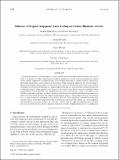Influence of Tropical Tropopause Layer Cooling on Atlantic Hurricane Activity
Author(s)
Solomon, Susan; Folini, Doris; Davis, Sean; Cagnazzo, Chiara; Emanuel, Kerry Andrew
DownloadEmanuel-2013-Influence of tropica.pdf (3.928Mb)
PUBLISHER_POLICY
Publisher Policy
Article is made available in accordance with the publisher's policy and may be subject to US copyright law. Please refer to the publisher's site for terms of use.
Terms of use
Metadata
Show full item recordAbstract
Virtually all metrics of Atlantic tropical cyclone activity show substantial increases over the past two decades. It is argued here that cooling near the tropical tropopause and the associated decrease in tropical cyclone outflow temperature contributed to the observed increase in tropical cyclone potential intensity over this period. Quantitative uncertainties in the magnitude of the cooling are important, but a broad range of observations supports some cooling. Downscalings of the output of atmospheric general circulation models (AGCMs) that are driven by observed sea surface temperatures and sea ice cover produce little if any increase in Atlantic tropical cyclone metrics over the past two decades, even though observed variability before roughly 1970 is well simulated by some of the models. Part of this shortcoming is traced to the failure of the AGCMs examined to reproduce the observed cooling of the lower stratosphere and tropical tropopause layer (TTL) over the past few decades. The authors caution against using sea surface temperature or proxies based on it to make projections of tropical cyclone activity as there can be significant contributions from other variables such as the outflow temperature. The proposed mechanisms of TTL cooling (e.g., ozone depletion and stratospheric circulation changes) are reviewed, and the need for improved representations of these processes in global models in order to improve projections of future tropical cyclone activity is emphasized.
Date issued
2013-04Department
Massachusetts Institute of Technology. Department of Chemistry; Massachusetts Institute of Technology. Department of Earth, Atmospheric, and Planetary Sciences; Massachusetts Institute of Technology. Program in Atmospheres, Oceans, and ClimateJournal
Journal of Climate
Publisher
American Meteorological Society
Citation
Emanuel, Kerry, Susan Solomon, Doris Folini, Sean Davis, and Chiara Cagnazzo. “Influence of Tropical Tropopause Layer Cooling on Atlantic Hurricane Activity.” Journal of Climate 26, no. 7 (April 2013): 2288-2301. © 2013 American Meteorological Society
Version: Final published version
ISSN
0894-8755
1520-0442